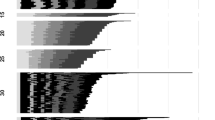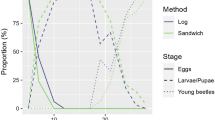Abstract
Phenology, the timing of developmental events such as oviposition or pupation, is highly dependent on temperature; since insects are ectotherms, the time it takes them to complete a life stage (development time) depends on the temperatures they experience. This dependence varies within and between populations due to variation among individuals that is fixed within a life stage (giving rise to what we call persistent variation) and variation from random effects within a life stage (giving rise to what we call random variation). It is important to understand how both types of variation affect phenology if we are to predict the effects of climate change on insect populations.
We present three nested phenology models incorporating increasing levels of variation. First, we derive an advection equation to describe the temperature-dependent development of a population with no variation in development time. This model is extended to incorporate persistent variation by introducing a developmental phenotype that varies within a population, yielding a phenotype-dependent advection equation. This is further extended by including a diffusion term describing random variation in a phenotype-dependent Fokker–Planck development equation. These models are also novel because they are formulated in terms of development time rather than developmental rate; development time can be measured directly in the laboratory, whereas developmental rate is calculated by transforming laboratory data. We fit the phenology models to development time data for mountain pine beetles (MPB) (Dendroctonus ponderosae Hopkins [Coleoptera: Scolytidae]) held at constant temperatures in laboratory experiments. The nested models are parameterized using a maximum likelihood approach. The results of the parameterization show that the phenotype-dependent advection model provides the best fit to laboratory data, suggesting that MPB phenology may be adequately described in terms of persistent variation alone. MPB phenology is simulated using phloem temperatures and attack time distributions measured in central Idaho. The resulting emergence time distributions compare favorably to field observations.
Similar content being viewed by others
References
Amman, G.D., 1972. Some factors affecting oviposition behavior of the mountain pine beetle. Environ. Entomol. 1(6), 691–695.
Bentz, B.J., 2006. Mountain pine beetle population sampling: inferences from Lindgren pheremone traps and tree emergence cages. Can. J. For. Res. 36, 351–360.
Bentz, B.J., Mullins, D.E., 1999. Ecology of mountain pine beetle (Coleoptera: Scolytidae) cold hardening in the intermountain west. Environ. Entomol. 28(4), 577–587.
Bentz, B.J., Logan, J.A., Amman, G.D., 1991. Temperature-dependent development of the mountain pine beetle (Coleoptera: Scolytidae) and simulation of its phenology. Can. Entomol. 123, 1083–1094.
Bentz, B.J., Logan, J.A., Vandygriff, J., 2001. Latitudinal variation in Dendroctonus ponderosae (Coleoptera: Scolytidae) development time and adult size. Can. Entomol. 133, 375–387.
Berryman, A.A., Dennis, B., Raffa, K.F., Stenseth, N.C., 1985. Evolution of optimal group attack, with particular reference to bark beetles (Coleoptera: Scolytidae). Ecology 66(3), 898–903.
Carroll, A., Taylor, S., Régnière, J., Safranyik, L., 2003. Effects of climate change on range expansion by the mountain pine beetle in British Columbia. In: Shore, T., Brooks, J., Stone, J. (Eds.), Mountain Pine Beetle Symposium: Challenges and Solutions. Information Report BC-X-399, pp. 223–232, Klowna, British Columbia, October 2003. Natural Resources Canada, Canadian Forest Service, Pacific Forestry Centre, Victoria, BC.
Cole, W.E., 1981. Some risks and causes of mortality in mountain pine beetle populations: a long-term analysis. Res. Popul. Ecol. 23(1), 116–144.
Danks, H.V., 1987. Insect Dormancy: An Ecological Prospective. Monograph Series, vol. 1. Biological Survey of Canada (Terrestrial Arthropods), Ottawa.
Eubank, W., Atmar, J., Ellington, J., 1973. The significance and thermodynamics of fluctuating versus static thermal environments on Helios zea egg development rates. Environ. Entomol. 2(4), 491–496.
Fokker, A.D., 1914. Die mittlere energie rotierender elektrischer dipole im strahlungsfeld. Ann. Phys. 43, 810–820.
Gilbert, E., Powell, J.A., Logan, J.A., 2004. Comparison of three models predicting developmental milestones given environmental and individual variation. Bull. Math. Biol. 66, 1821–1850.
Jenkins, J.L., Powell, J.A., Logan, J.A., Bentz, B.J., 2001. Low seasonal temperatures promote life cycle synchronization. Bull. Math. Biol. 63(3), 573–595.
Kramers, H.A., 1940. Brownian motion in a field of force and the diffusion model of chemical reactions. Physica 7, 284–304.
Logan, J.A., 1988. Toward an expert system for development of pest simulation models. Environ. Entomol. 17(2), 359–376.
Logan, J.A., Amman, G.D., 1986. A distribution model for egg development in mountain pine beetle. Can. Entomol. 118, 361–372.
Logan, J.A., Powell, J.A., 2001. Ghost forests, global warming and the mountain pine beetle. Am. Entomol. 47, 160–173.
Logan, J.A., Wollkind, D.J., Hoyt, S.C., Tanigoshi, L.K., 1976. An analytic model for description of temperature dependent rate phenomena in arthropods. Environ. Entomol. 5(6), 1133–1140.
Logan, J., Bolstad, P., Bentz, B., Perkins, D., 1995. Assessing the effects of changing climate on mountain pine beetle dynamics. In: Interior West Global Change Workshop. General Technical Report RM-GTR-262, pp. 92–105, Fort Collins, Colorado, April 1995. USDA Forest Service, Rocky Mountain Forest and Range Experiment Station.
Memmott, J., Craze, P.G., Waser, N.M., Price, M.V., 2007. Global warming and the disruption of plant-pollinator interactions. Ecol. Lett. 10, 710–717.
Moyal, J.E., 1949. Stochastic processes and statistical physics. J. R. Stat. Soc. Ser. B (Methodol.) 11(2), 150–210.
Parmesan, C., Yohe, G., 2003. A globally coherent fingerprint of climate change impacts across natural systems. Nature 421, 37–42.
Planck, M., 1917. Ueber einen satz der statistichen dynamik und eine erweiterung in der quantumtheorie. Sitzungsber. Konigl. Preuß. Akad. Wiss. 324–341.
Powell, J.A., Logan, J.A., 2005. Insect seasonality: circle map analysis of temperature-driven life cycles. Theor. Popul. Biol. 67, 161–179.
Powell, J.A., Jenkins, J.L., Logan, J.A., Bentz, B.J., 2000. Seasonal temperature alone can synchronize life cycles. Bull. Math. Biol. 62(5), 977–998.
Raffa, K.F., Berryman, A.A., 1983. The role of host plant resistance in the colonization behavior and ecology of bark beetles (Coleoptera: Scolytidae). Ecol. Monogr. 53(1), 27–49.
Risken, H., 1996. The Fokker–Planck Equation: Methods of Solution and Applications, 2nd edn. Springer, Berlin.
Safranyik, L., Carrol, A.L., 2006. The biology and epidemiology of the mountain pine beetle in lodgepole pine forests. In: The Mountain Pine Beetle: A Synthesis of Biology, Management, and Impacts on Lodgepole Pine, pp. 3–66. Natural Resources Canada, Canadian Forest Service, Pacific Forestry Centre, Victoria, British Columbia
Sharpe, P., DeMichele, D., 1977. Reaction kinetics of poikilotherm development. J. Theor. Biol. 64, 649–670.
Sharpe, P., Curry, G., DeMichele, D., Cole, C., 1977. Distribution model of organism development times. J. Theor. Biol. 66, 21–38.
Stinner, R.E., Butler, J.G.D., Bacheler, J.S., Tuttle, C., 1975. Simulation of temperature-dependent development in population dynamics models. Can. Entomol. 107, 1167–1174.
Taylor, F., 1981. Ecology and the evolution of physiological time in insects. Am. Nat. 117(1), 1–23.
Visser, M.E., Holleman, L.J.M., 2001. Warmer springs disrupt the synchrony of oak and winter moth phenology. Proc. R. Soc. Lond. 268, 289–294.
Yurk, B.P., 2009. Modeling the evolution of insect phenology with particular reference to mountain pine beetle. PhD thesis, Utah State University.
Yurk, B.P., Powell, J.A., 2009. Modeling the evolution of insect phenology. Bull. Math. Biol. 71, 952–979.
Zaslavski, V., 1988. Insect Development: Photoperiodic and Temperature Control. Springer, Berlin.
Author information
Authors and Affiliations
Corresponding author
Additional information
This work was completed while Brian Yurk was a doctoral student at Utah State University.
Rights and permissions
About this article
Cite this article
Yurk, B.P., Powell, J.A. Modeling the Effects of Developmental Variation on Insect Phenology. Bull. Math. Biol. 72, 1334–1360 (2010). https://doi.org/10.1007/s11538-009-9494-7
Received:
Accepted:
Published:
Issue Date:
DOI: https://doi.org/10.1007/s11538-009-9494-7




